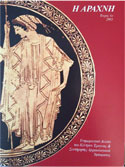Production
Older than metallurgy and ceramic art, textile production is an example of cognitive archaeology. In order to create a fabric, it is necessary that weavers have a clear image of the end-product in their mind so that the appropriate decisions are taken at any stage according to the desired result. Textile production is, therefore, a combination of mental and practical actions, calculations and skills, that creates artefacts containing valuable information on the society that produced them. The production chain is long, laborious and time-consuming, while at the same time it is a ceaseless action, an unbroken chain, a perpetual continuum of alternating stages, that reach the end only to start again.
Textile technology is a combination of various parameters that reflect the level of knowledge and skills of the culture that produces them. It can be deciphered by the study of the sociological and technological aspects of the production. This study can be divided into two main sections: first, in the organisation of the production, looking into the place of production, the roles according to gender, the relevant professions and any specialisation within them, and second, in the technology of the production, such as the selection of raw materials, the production and decoration techniques, the dyes and finishing of textiles.
Textile production procedures were similar regardless whether they took place at the house or the workshop. After careful processing, the fibres were made into threads that would be used on the various types of looms. In ancient Greece, fibres were spun on the spindle, with methods that are still used nowadays in certain areas of Greece.
The most common type of loom used in ancient Greece was the warp-weighted loom. It can be studied in ancient texts, seen in iconography and found through its only archaeological trace, the numerous loom-weights retrieved at excavations. Other textile making techniques were also practiced simultaneously to weaving. Different types of loom, such as the up-standing or horizontal two-beam loom, could have been used in ancient Greece, but neither any tangible evidence has been retrieved up till now, nor any testimony in ancient texts or iconography has been identified.
The decoration of the textiles was taking place either simultaneously or after the production was completed, and various techniques were applied. Iconographical sources show colourful textiles decorated with stripes, geometric and figurative patterns, fringes, etc.
Textile processing does not end, even after the completion of the fabric’s production, by means of weaving or any other technique. To begin with, there are many types of decoration, such as embroidery, that only take place on a finished textile. In ancient Greece there were specialised craftsmen, the fullers, known as knapheis, specifically working on the post-processing of textiles between production and consumption.


